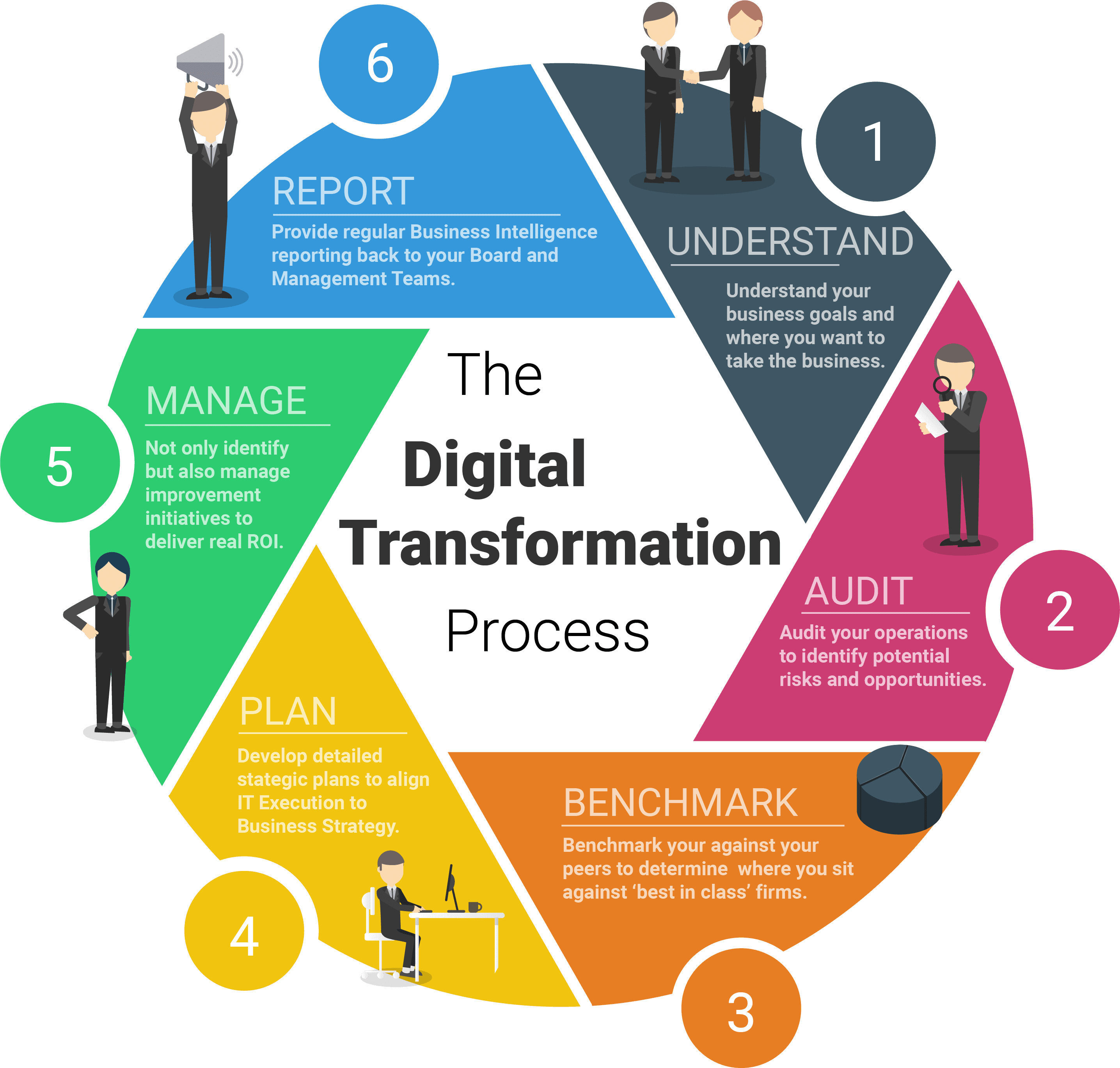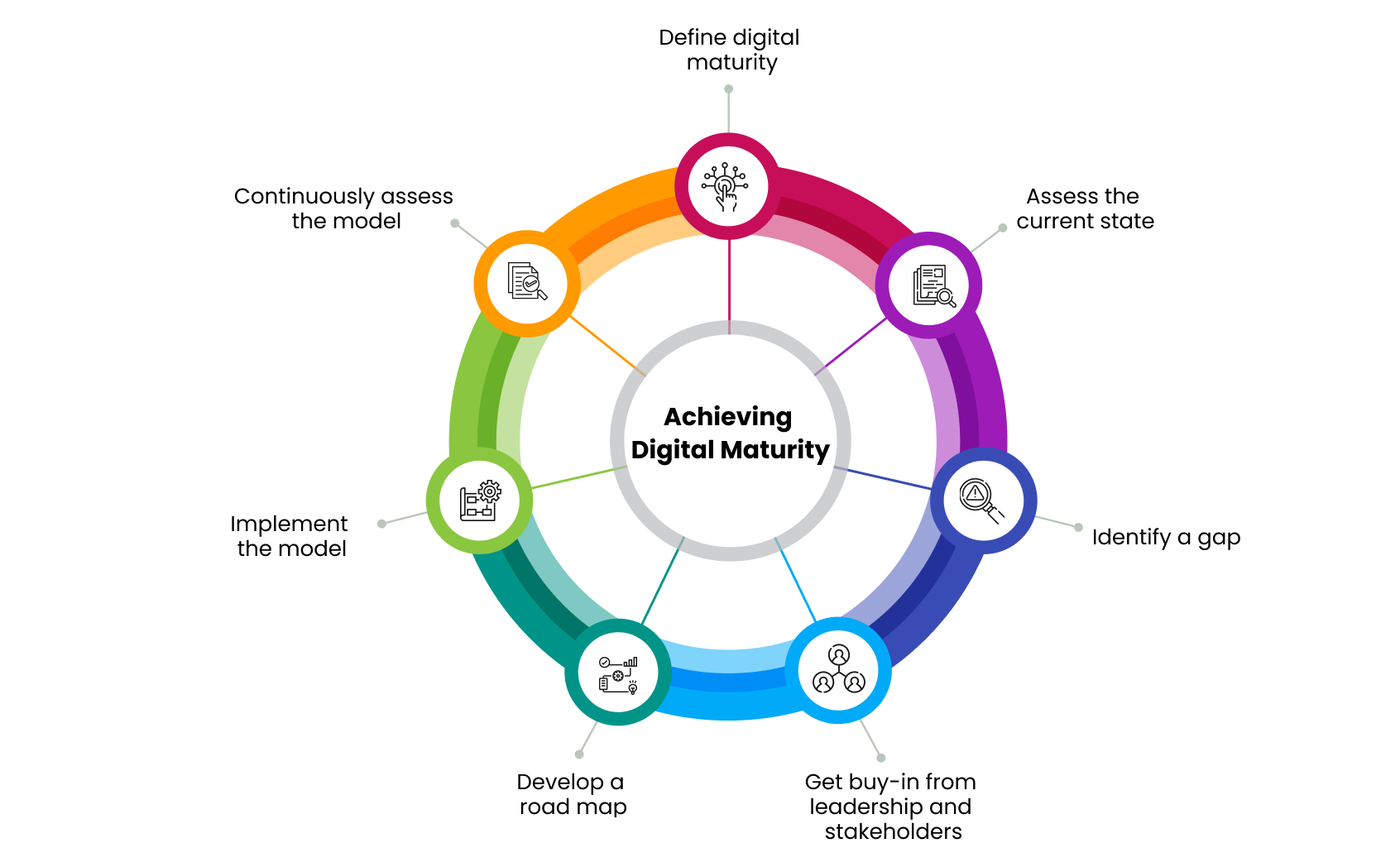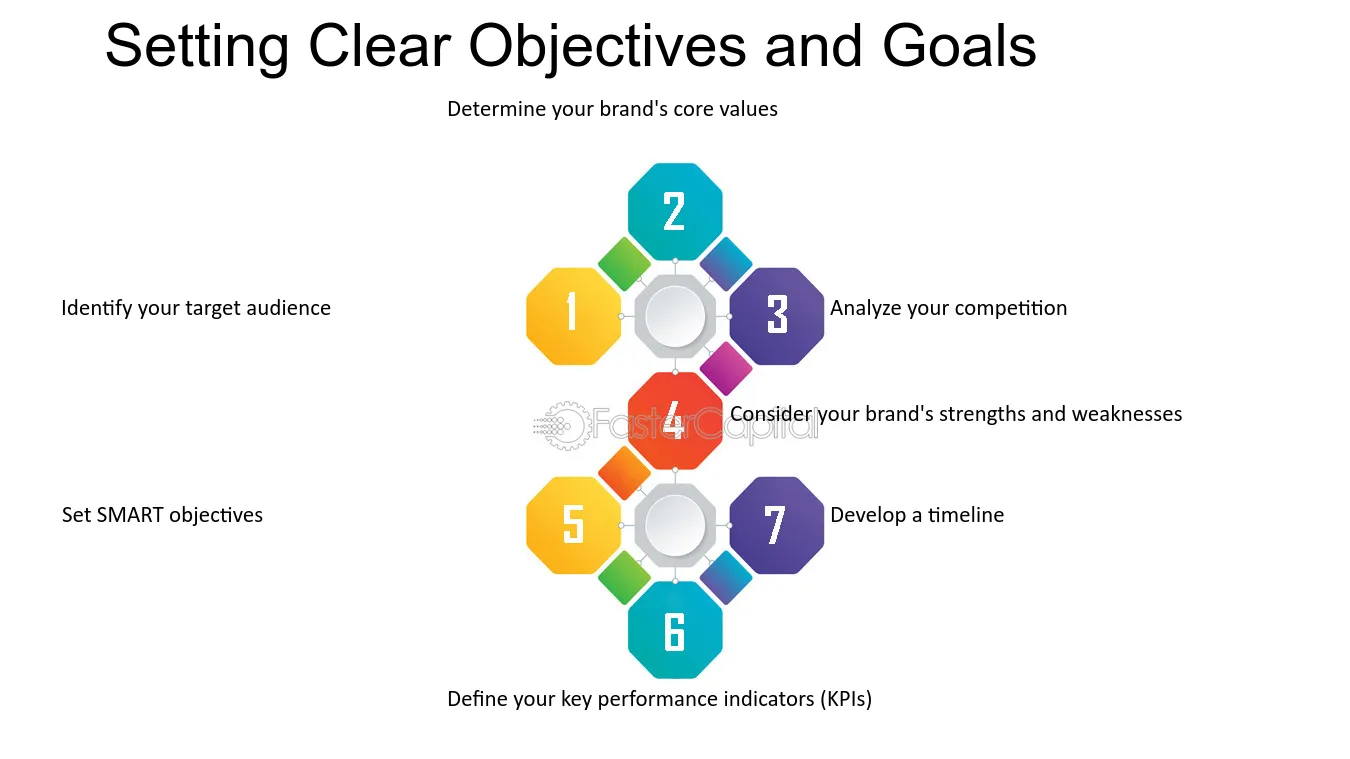Digital Transformation: Key Steps to Modernize Your Business in 2025
Digital transformation is not just a buzzword; it is an imperative for businesses seeking to thrive in the modern digital age. As we move into 2025, the pace of technological advancement continues to accelerate, making it crucial for organizations to modernize their operations, enhance customer experiences, and stay competitive. This comprehensive guide will explore the key steps to achieve successful digital transformation in 2025, ensuring your business is equipped to navigate the digital landscape effectively.
Table of Contents
- Introduction
- Assessing Your Current Digital Maturity
- Setting Clear Objectives and Goals
- Building a Strong Digital Culture
- Leveraging Emerging Technologies
- Enhancing Customer Experience
- Optimizing Business Processes
- Ensuring Cybersecurity and Data Privacy
- Developing a Comprehensive Digital Strategy
- Investing in the Right Technologies and Solutions
- Managing Change and Overcoming Resistance
- Measuring Success and Continuous Improvement
- Case Studies of Successful Digital Transformations
- Conclusion
1. Introduction
Definition of Digital Transformation
Digital transformation refers to the integration of digital technology into all areas of a business, fundamentally changing how the organization operates and delivers value to customers. It involves the adoption of new technologies, processes, and cultural shifts to improve efficiency, enhance customer experiences, and drive innovation.

Importance of Digital Transformation in 2025
In 2025, digital transformation remains critical for businesses due to the rapid pace of technological advancements and the increasing expectations of customers. Companies that fail to embrace digital transformation risk falling behind competitors, losing market share, and becoming obsolete. The benefits of digital transformation include increased operational efficiency, better decision-making through data analytics, improved customer satisfaction, and the ability to innovate and adapt quickly to market changes.
Learn more about the importance of digital transformation.
2. Assessing Your Current Digital Maturity
Conducting a Digital Maturity Assessment
Before embarking on a digital transformation journey, it is essential to assess your current digital maturity. This involves evaluating your existing technology infrastructure, digital capabilities, and organizational readiness. A digital maturity assessment helps identify strengths, weaknesses, and areas that require improvement.

Key components of a digital maturity assessment include:
- Technology Infrastructure: Evaluating the current state of your IT systems, software, and hardware.
- Digital Capabilities: Assessing your ability to leverage digital tools and technologies.
- Organizational Readiness: Gauging the level of digital literacy, skills, and cultural readiness within your organization.
Check out this article on conducting a digital maturity assessment.
Identifying Gaps and Opportunities
Once the assessment is complete, analyze the results to identify gaps and opportunities for improvement. This analysis will help prioritize areas that need immediate attention and guide the development of a strategic roadmap for digital transformation. Common gaps may include outdated technology, lack of digital skills, inefficient processes, and inadequate cybersecurity measures.
3. Setting Clear Objectives and Goals
Defining Your Digital Transformation Vision
A successful digital transformation requires a clear vision that outlines the desired future state of the organization. This vision should be aligned with the overall business strategy and should articulate how digital transformation will enhance the company’s value proposition, competitive advantage, and customer experience.

Establishing Measurable Goals
With a clear vision in place, the next step is to establish measurable goals that will guide the transformation efforts. These goals should be specific, achievable, relevant, and time-bound (SMART).
Examples of digital transformation goals include:
- Increasing online sales by 30% within one year.
- Reducing operational costs by 20% through process automation.
- Enhancing customer satisfaction scores by 15% within six months.
Measurable goals provide a benchmark for success and help track progress throughout the transformation journey.
4. Building a Strong Digital Culture
Fostering a Culture of Innovation
A strong digital culture is essential for the success of any digital transformation initiative. This involves fostering a culture of innovation where employees are encouraged to experiment, take risks, and embrace new ideas. Leaders should promote an environment that values creativity, collaboration, and continuous learning.

Promoting Digital Literacy and Skills Development
Digital literacy is a critical component of a digital culture. Organizations must invest in training and development programs to enhance the digital skills of their workforce. This includes providing access to online courses, workshops, and certifications in areas such as data analytics, cybersecurity, artificial intelligence, and digital marketing.
5. Leveraging Emerging Technologies
Artificial Intelligence and Machine Learning
Artificial Intelligence (AI) and Machine Learning (ML) are revolutionizing various industries by enabling automation, predictive analytics, and personalized customer experiences. Businesses can leverage AI and ML to enhance decision-making, optimize operations, and deliver targeted marketing campaigns.
Learn more about AI and ML solutions in Devensis’ AI & Machine Learning article.
Internet of Things (IoT)
The Internet of Things (IoT) connects physical devices to the internet, enabling real-time data collection and analysis. IoT can improve operational efficiency, enhance asset management, and provide valuable insights into customer behavior. For example, smart sensors can monitor equipment performance and predict maintenance needs, reducing downtime and costs.
Blockchain Technology
Blockchain technology offers secure and transparent transactions, making it valuable for industries such as finance, supply chain, and healthcare. By implementing blockchain, businesses can enhance data security, streamline processes, and improve traceability.
5G Connectivity
The rollout of 5G connectivity promises faster internet speeds, lower latency, and increased capacity. Businesses can leverage 5G to support advanced technologies like IoT, augmented reality (AR), and virtual reality (VR), enhancing customer experiences and enabling innovative applications.
Learn more about these emerging technologies here.
6. Enhancing Customer Experience
Understanding Customer Needs and Preferences
A customer-centric approach is vital for digital transformation success. Businesses must invest in understanding their customers’ needs, preferences, and pain points. This can be achieved through customer surveys, feedback forms, and data analytics.
Implementing Customer-Centric Strategies
Based on customer insights, develop and implement strategies that prioritize customer satisfaction and loyalty. This may include personalized marketing, seamless omnichannel experiences, and responsive customer service.
Utilizing Customer Data for Personalization
Personalization is key to delivering exceptional customer experiences. By leveraging customer data, businesses can create tailored content, offers, and recommendations that resonate with individual customers. Advanced analytics and AI can help analyze customer data and predict future behaviors, enabling proactive engagement.
For deeper insights, click here.
7. Optimizing Business Processes
Automating Processes with Robotic Process Automation (RPA)
Robotic Process Automation (RPA) involves using software robots to automate repetitive and rule-based tasks. RPA can significantly improve efficiency, reduce errors, and free up employees to focus on higher-value activities. Common use cases for RPA include data entry, invoice processing, and customer support.
Streamlining Operations through Business Process Management (BPM)
Business Process Management (BPM) is a systematic approach to optimizing and improving business processes. By analyzing and redesigning workflows, businesses can enhance productivity, reduce costs, and ensure consistent quality. BPM tools provide visibility into process performance and enable continuous improvement.
8. Ensuring Cybersecurity and Data Privacy
Implementing Robust Cybersecurity Measures
As businesses become more digital, cybersecurity becomes increasingly important. Implementing robust cybersecurity measures is crucial to protect sensitive data and prevent cyberattacks. This includes deploying firewalls, encryption, multi-factor authentication, and regular security audits.
Ensuring Compliance with Data Protection Regulations
Compliance with data protection regulations, such as the General Data Protection Regulation (GDPR) and the California Consumer Privacy Act (CCPA), is essential for building trust with customers and avoiding legal penalties. Businesses must establish policies and procedures to ensure data privacy and protect customer information.
Explore more on cybersecurity and data privacy.
9. Developing a Comprehensive Digital Strategy
Aligning Digital Initiatives with Business Objectives
A comprehensive digital strategy aligns digital initiatives with the overall business objectives. This involves identifying key digital projects, prioritizing them based on their impact and feasibility, and ensuring they support the company’s strategic goals.
Creating a Roadmap for Digital Transformation
A digital transformation roadmap outlines the steps and milestones required to achieve the desired outcomes. It provides a clear timeline, assigns responsibilities, and identifies the resources needed for each phase of the transformation. A well-defined roadmap ensures that the transformation process is structured and manageable.
10. Investing in the Right Technologies and Solutions
Evaluating Technology Vendors
Choosing the right technology vendors is critical for the success of digital transformation initiatives. Evaluate vendors based on their expertise, reliability, scalability, and support services. Conduct thorough research, request demonstrations, and seek customer references to make informed decisions.
Prioritizing Scalable and Flexible Solutions
Invest in scalable and flexible solutions that can grow with your business and adapt to changing needs. Cloud-based platforms, for example, offer scalability, cost-efficiency, and accessibility. Ensure that the chosen technologies can integrate seamlessly with your existing systems and support future expansion.
Learn more about benefits and advanatges of React Native in Devensis’ article.
11. Managing Change and Overcoming Resistance
Implementing Change Management Strategies
Effective change management is essential to navigate the challenges of digital transformation. This involves communicating the vision and benefits of the transformation, involving employees in the process, and providing training and support. Change management strategies help mitigate resistance and ensure smooth adoption of new technologies and processes.
Addressing Employee Concerns and Resistance
Employee resistance is a common barrier to digital transformation. Address concerns by fostering open communication, providing reassurance, and highlighting the positive impact of the transformation on their roles. Encourage a growth mindset and offer opportunities for upskilling and career development.
12. Measuring Success and Continuous Improvement
Defining Key Performance Indicators (KPIs)
To measure the success of digital transformation initiatives, define key performance indicators (KPIs) that align with your goals. KPIs may include metrics related to customer satisfaction, operational efficiency, revenue growth, and digital adoption rates. Regularly track and analyze these metrics to assess progress.
Continuously Monitoring and Refining Strategies
Digital transformation is an ongoing process that requires continuous monitoring and refinement. Use data-driven insights to identify areas for improvement, make informed decisions, and adapt strategies as needed. Embrace a culture of continuous improvement to stay agile and responsive to changing market conditions.
13. Case Studies of Successful Digital Transformations
Examples from Leading Companies
- Amazon: Amazon’s digital transformation journey involves leveraging AI, data analytics, and cloud computing to enhance customer experiences, optimize logistics, and drive innovation. Their focus on continuous improvement and customer-centricity has made them a leader in e-commerce and technology.
- General Electric (GE): GE’s digital transformation focuses on industrial IoT and data analytics to optimize operations and drive innovation. By connecting machines and analyzing data, GE improves efficiency, reduces costs, and enhances product development.
- Starbucks: Starbucks utilizes digital technologies to enhance customer experiences through personalized marketing, mobile ordering, and loyalty programs. Their investment in data analytics and AI enables them to understand customer preferences and deliver tailored experiences.
Lessons Learned and Best Practices
- Leadership Commitment: Successful digital transformation requires strong leadership commitment and a clear vision.
- Customer-Centric Approach: Prioritize customer needs and preferences to drive meaningful transformation.
- Continuous Learning: Foster a culture of continuous learning and innovation to stay ahead of technological advancements.
- Data-Driven Decisions: Leverage data analytics to make informed decisions and optimize processes.
- Agility and Flexibility: Embrace agility and flexibility to adapt to changing market conditions and emerging technologies.
Conclusion
Recap of Key Steps
Digital transformation is a critical journey for businesses seeking to thrive in the digital age. The key steps to modernize your business in 2025 include assessing your digital maturity, setting clear objectives, building a strong digital culture, leveraging emerging technologies, enhancing customer experiences, optimizing business processes, ensuring cybersecurity, developing a comprehensive digital strategy, investing in the right technologies, managing change, measuring success, and learning from successful case studies.
Final Thoughts on Digital Transformation in 2025
As we move into 2024, the importance of digital transformation cannot be overstated. By embracing digital technologies and fostering a culture of innovation, businesses can enhance their competitiveness, improve customer experiences, and drive sustainable growth. The journey may be challenging, but with a clear vision, strategic planning, and commitment to continuous improvement, organizations can successfully navigate the digital landscape and achieve their transformation goals.
Learn more about Devensis’ solutions here.

FAQ:
Q1: What is digital transformation and why is it important for my business in 2025?
A1: Digital transformation refers to the integration of digital technology into all areas of a business, fundamentally changing how the organization operates and delivers value to customers. In 2025, it is crucial because it helps businesses stay competitive, improve efficiency, enhance customer experiences, and drive innovation in an increasingly digital world.
Q2: How can I assess my company’s current digital maturity?
A2: Conducting a digital maturity assessment involves evaluating your existing technology infrastructure, digital capabilities, and organizational readiness. This can be done through surveys, interviews, and analysis of current processes and technologies. Identifying gaps and opportunities helps prioritize areas for improvement and guides your digital transformation strategy.
Q3: What are some emerging technologies that can benefit my business in the digital transformation process?
A3: Emerging technologies that can significantly benefit your business include Artificial Intelligence (AI), Machine Learning (ML), the Internet of Things (IoT), blockchain technology, and 5G connectivity. These technologies can enhance decision-making, optimize operations, improve customer experiences, and support innovative applications.
Q4: How can my business enhance customer experience through digital transformation?
A4: Enhancing customer experience involves understanding customer needs and preferences through data analytics, implementing customer-centric strategies, and personalizing interactions using customer data. Leveraging technologies like AI and IoT can also help provide more personalized and efficient services.
Q5: What steps should I take to ensure cybersecurity and data privacy during digital transformation?
A5: To ensure cybersecurity and data privacy, implement robust measures such as firewalls, encryption, multi-factor authentication, and regular security audits. Additionally, comply with data protection regulations like GDPR and CCPA by establishing policies and procedures to protect customer information and ensure data privacy.
Q6: How do I measure the success of my digital transformation efforts?
A6: Measure the success of digital transformation efforts by defining key performance indicators (KPIs) that align with your goals. Common KPIs include metrics related to customer satisfaction, operational efficiency, revenue growth, and digital adoption rates. Regularly track and analyze these metrics to assess progress and make data-driven decisions for continuous improvement.

